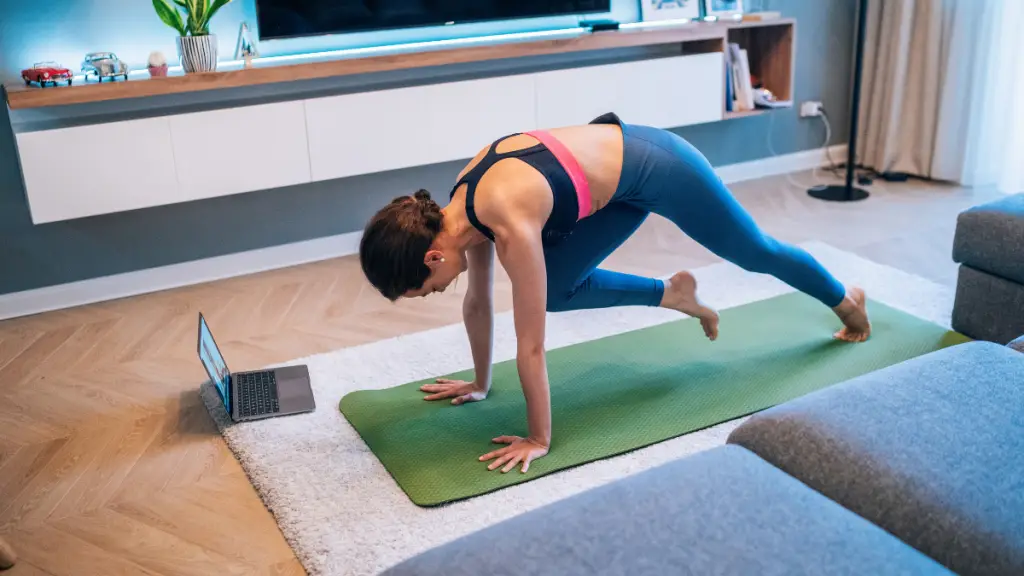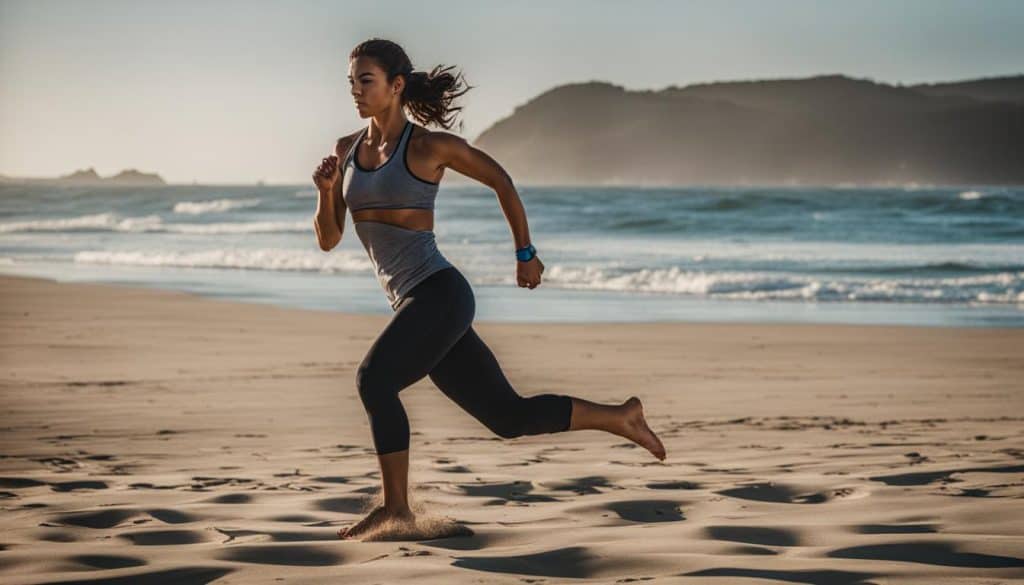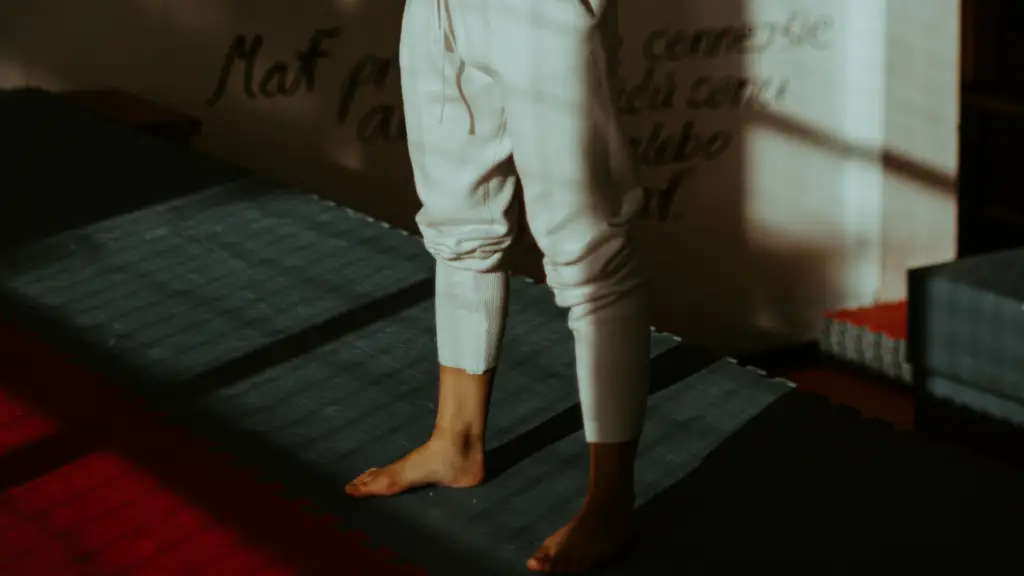
I’m often asked, “Can I do a HIIT workout barefoot?” It’s a valid question, considering the growing popularity of exercising without shoes. There’s a belief that our bodies have evolved to live without the confines of footwear, and that going barefoot can actually reduce the risk of injury and improve foot health.
While there seems to be some truth to these claims, the research on the benefits and risks of barefoot exercise is limited. So, it’s important to approach barefoot HIIT workouts with caution and ensure we have a solid understanding of the potential effects.
Key Takeaways:
- Barefoot HIIT workouts have gained popularity due to the perceived benefits of natural foot movement and improved foot health.
- Research on the safety and effectiveness of barefoot HIIT is limited and requires further investigation.
- Individual factors, workout type, and the condition of the workout area should be considered before deciding to go barefoot.
- Consulting with a healthcare professional or fitness expert can help determine the suitability of barefoot HIIT workouts for your specific needs and goals.
- Always listen to your body and prioritize safety when engaging in any form of physical activity.
The Importance of Foot Strength and Proprioception
Our feet play a crucial role in providing proprioception, which helps us maintain balance and stability.
Exercising barefoot can enhance this sensory feedback and strengthen the 34 muscles of our feet and lower legs. It also promotes mindfulness and grounding.
Here are some tips for incorporating barefoot HIIT workouts into your training routine:
- Ensure you have a safe and clean workout surface to prevent injuries and minimize discomfort.
- Start with shorter, low-impact exercises to allow your feet to adapt gradually.
- Focus on proper form and alignment during each exercise to maximize the activation of your foot muscles.
- Listen to your body and take breaks when needed. Going barefoot may require some time for your feet to adjust.
“Exercising barefoot can improve foot strength and proprioception, leading to enhanced balance and stability.”
Remember, going barefoot is not suitable for everyone and may depend on individual factors such as foot health and workout types. It’s always a good idea to consult with a healthcare professional or fitness expert before starting any new training regimen.

Stay tuned for the next section where we’ll explore the impact of footwear on foot health.
The Impact of Footwear on Foot Health
When it comes to barefoot HIIT workouts, one of the key factors to consider is the impact of footwear on foot health. Traditional shoes with cushioning and arch support can often limit the natural movement of the foot, leading to weakened foot muscles and imbalances. This can increase the risk of various foot conditions and injuries.
On the other hand, going barefoot allows the foot to function in its natural position and engage the muscles more effectively. Without the interference of shoes, the foot has the freedom to move and adapt to the workout movements, which can strengthen the foot and lower leg muscles over time.
Here are some key pros and cons of barefoot HIIT workouts:
| Pros | Cons |
|---|---|
|
|
While barefoot HIIT workouts can have their benefits, it’s important to note that not all exercises are ideal for going shoeless. Some exercises, such as plyometric movements or high-impact exercises like jumping jacks, may require the use of supportive footwear to minimize the risk of injury.
Remember, before starting any new exercise regimen, it is always a good idea to consult with a healthcare professional or fitness expert. They can provide personalized advice based on your individual needs and goals.
Engaging in barefoot HIIT workouts can be a unique and fulfilling experience. By understanding the impact of footwear on foot health and considering the pros and cons, you can make an informed decision on whether to incorporate barefoot training into your HIIT routine.
When to Wear Shoes for HIIT Workouts
While barefoot training can have benefits, it is not suitable for everyone. It’s important to consider safety and the advantages of doing HIIT barefoot to make an informed decision.
The Safety of Barefoot HIIT Workouts
Engaging in barefoot HIIT workouts can provide a greater awareness of body mechanics and improve foot strength. However, there are certain circumstances when wearing shoes is necessary to ensure safety:
- Individuals with foot conditions: If you have existing foot conditions such as plantar fasciitis or Achilles tendonitis, it is essential to wear appropriate footwear that provides support and cushioning.
- Biomechanical issues: If you have biomechanical imbalances such as overpronation or supination, wearing supportive shoes can help correct your gait and prevent excessive stress on your feet and ankles.
- Medical conditions affecting foot sensation: If you have conditions such as peripheral neuropathy, diabetes, or any other medical condition that affects foot sensation, wearing shoes is crucial to protect your feet from injury.
Advantages of Doing HIIT Barefoot
Despite the safety considerations, there are notable advantages to performing HIIT workouts without shoes:
- Improved balance and proprioception: Exercising barefoot allows your feet to engage directly with the ground, enhancing sensory feedback and improving balance and stability during dynamic movements.
- Strengthening of foot muscles: Going barefoot engages the numerous muscles in your feet, which are often neglected when wearing traditional shoes. This can improve foot strength and stability, reducing the risk of injuries.
- Mind-body connection: Exercising barefoot promotes a greater connection between your body and the ground, enhancing mindfulness and grounding, which can enhance your overall workout experience.
Ultimately, the decision to wear shoes or go barefoot during your HIIT workouts should be based on individual factors, personal preferences, and safety considerations. Always consult with a healthcare professional or a qualified fitness trainer to determine what is suitable for your specific needs and goals.

Conclusion
After considering the benefits and risks of barefoot HIIT workouts, it is evident that there is still limited evidence to support their safety and effectiveness. While the idea of exercising barefoot may seem appealing, it is crucial to prioritize individual factors and workout type before deciding whether to go barefoot.
Factors such as foot conditions, biomechanical issues, and medical conditions affecting foot sensation should be taken into account when considering barefoot workouts. Additionally, exercises with higher impact movements, like running or jumping, may require the use of supportive footwear to prevent injuries.
In order to make an informed decision about whether to incorporate barefoot HIIT workouts into your fitness routine, it is advisable to consult with a healthcare professional or fitness expert. They can provide personalized guidance based on your specific needs and goals, ensuring that you exercise safely and effectively.
FAQ
Can I do a HIIT workout barefoot?
Yes, you can do a HIIT workout barefoot. Exercising without shoes can enhance sensory feedback and strengthen the muscles in your feet and lower legs.
What are the benefits of doing HIIT barefoot?
Exercising barefoot can improve foot health, enhance proprioception, promote mindfulness, and engage foot muscles more effectively.
Are there any tips for barefoot HIIT workouts?
Yes, make sure to choose a workout area with a clean and safe surface, start with lower impact movements, and listen to your body to avoid overexertion or injury.
What are the pros and cons of barefoot HIIT?
The pros of barefoot HIIT include improved foot strength and proprioception. The cons include potential risks of injury and lack of research supporting its safety and effectiveness.
When should I wear shoes for HIIT workouts?
Shoes should be worn for HIIT workouts if you have foot conditions, biomechanical issues, medical conditions affecting foot sensation, or if you are performing exercises with high impact movements like running or jumping.
Source Links
- https://www.wellandgood.com/okay-workout-barefoot-home/
- https://foreverfitscience.com/hiit/should-your-next-hiit-workout-be-barefoot/
- https://www.byrdie.com/do-you-need-to-wear-shoes-for-home-workouts-5116038
Hey there, I’m Luke, and I’ve been immersed in the fitness world since 2007. From gym floors to running my own personal training business, I’ve seen it all. My journey led me to study Sports Science at university, where I deepened my understanding of the science behind exercise.
One thing that truly lights my fire? High-Intensity Interval Training (HIIT). It’s not just a workout; it’s a game-changer. I’ve used HIIT to help countless men and women shed weight and transform their lives for the better.
Through my personal training business, I’ve witnessed the incredible impact of HIIT on both physical and mental well-being. It’s not just about getting fitter; it’s about feeling stronger, more confident, and more resilient.
Join me on this journey to a healthier, happier you. Let’s crush those goals together!